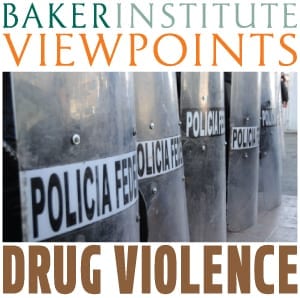As a presidential candidate, Enrique Peña Nieto (PRI) claimed he would bring a new strategy to the country’s struggle with organized crime — one that de-emphasized the targeting of drug kingpins and focused on reducing homicides, extortion cases and kidnappings.
One year into the presidency, Peña Nieto’s administration claims that the homicide rate has dropped by 18 percent; on the other hand, government stats point to a 35 percent increase in kidnappings. After the arrest of two major Zeta and Gulf Cartel leaders earlier this year, Peña Nieto’s strategy shift appears to be more rhetorical than real. Many scholars, analysts and civil society leaders have taken issue with the claim that drug-related violence has declined. Recognizing the importance of understanding drug-related violence in Mexico, Baker Institute Viewpoints invited five scholars to respond to the question, “Has drug violence in Mexico declined?”
Read other posts in this series:
- In Mexico, security is in the eye of the beholder by Sylvia Longmire, former Air Force officer and special agent with the Air Force Office of Special Investigations
- Measuring mayhem: The challenge of assessing violence and insecurity in Mexico by John Sullivan, lieutenant in the Los Angeles County Sheriff’s Department
- Mexico’s national crime statistics show no significant decline in homicides and disappearances by Molly Molloy, research librarian and border specialist at the New Mexico State University Library
- Mexico must address violence and profitability by Nathan Jones, drug policy fellow at Rice University’s Baker Institute
In attempting to answer the question, “Is drug-related violence in Mexico going down?” the first casualty is the truth. The tragic fact is that it is quite impossible to determine the true levels of national drug-related violence, due to numerous quantitative issues. Therefore, without the existence of a credible baseline, attempts to establish whether drug violence in Mexico is trending downwards, upwards or remaining steady are highly problematic. Still, one can extrapolate based on perceptions and inferences.
The first issue in trying to decipher the truth is related to the question: What exactly is drug-related violence? It would be a safe bet to say that it includes the violence of the cartels and gangs — whose principal revenue source is illicit narcotics — targeting each other, government agents and innocent civilians. We should also count the violence committed by Mexican law enforcement and the military — who can either be acting as agents of the state or those personnel and units co-opted by the cartels — against cartels and gangs, and sometimes also against other government agents and civilians caught in the wrong place at the wrong time.
This issue becomes muddled if we attempt to consider cartel and gang violence that is unrelated to drugs. For some time now, many of the cartels in Mexico have evolved beyond just drug trafficking and are now diverse illicit enterprises involved in a host of nefarious activities including murder for hire, extortion and kidnapping, street taxation, human smuggling and trafficking, sexual slavery and prostitution, bulk thefts, and the sales of cloned goods. Should the violence generated by such illicit activities count as drug violence, even if it is not specifically drug-related? Furthermore, the violence tied to the rise of vigilantes and local militias (e.g., community police) in a number of regions in Mexico could also conceivably be counted. Yet these local militias emerged not to combat the drug trafficking activities of gangs and cartels, but the violence they directed at local communities through various other illicit enterprises.
Once we move beyond what types of violence should count as drug violence, we come to a second issue — the question of whether such drug-related and affiliated forms of violence are being accurately documented. There are multiple agendas for those reporting and influencing the reporting of this violence. At this point, many of the reporters themselves and the media outlets they represent are operating in survival mode, plain and simple. Numerous reporters have been threatened, beaten, kidnapped, tortured and killed. Media offices, in turn, have been subject to grenade attacks, arson, drive-by shootings and direct assault. When a plaza boss, corrupt city official or senior commanding military officer dictates to a reporter whether an incident can be covered in a local paper or not, the reporter — at least those who value their own safety and that of their families — will typically acquiesce. Still other reporters have been bought and paid for by the cartels and others profiting from illicit drug trafficking and related criminal activities. They are thus willing accomplices to the “reportage charade” taking place. Attempts to address the reporting problem have resulted in the rise of social media, such as blogs and Twitter feeds. Such media, however, can be highly unreliable and subject to its own capitalist agendas (such as the Blog del Narco scandal) while also threatened with cartel intimidation and even heinous executions of some of the bloggers.
Thus, trends in drug-related violence in Mexico are shaped by perception (e.g., attempts to accurately define reality) and intent (e.g., attempts to shape reality). Of the two approaches, perception is the preferred one; it seeks the truth rather than creating a narrative in order to further some sort of agenda. Official Mexican government statistics, therefore, are part of a “cooking the books” approach to reporting violence. First, the numbers reported over the last seven years were made artificially low (by only counting some of the killings and altogether ignoring the disappeared individuals), and then, when outcry arose over this method, the reporting ceased altogether. This fits hand-in-glove with the political agenda that prevails — an agenda of making the incumbent administration look good, keeping tourism robust and ensuring that the overall economy is not damaged by negative press.
With this in mind, the scholarship of Molly Molloy, who estimates 130,000 deaths and 27,000 disappearances in Mexico from gang and cartel violence in addition to the actions of local militias in Michoacán and at least eight other states, rings truer than the hollow statistics manufactured out of Mexico City. But even when an official violence report that appears to have some validity is published — such as the recent crime report released by the National Institute of Statistics and Geography (INEGI) — the news for Mexico is not necessarily good. Concerning that report:
Mexico’s crime rate rose 16.9 percent in 2012, compared to 2011, with one of every three households affected by crime … A total of 27.7 million crimes, or 35,139 crimes for every 100,000 inhabitants, were registered last year … Of the total crimes occurring in Mexico, only 7.9 percent led to the opening of an investigation, with an estimated 92.1 percent of crimes going unreported or never becoming the subject of an [investigation], the INEGI said.
Impunity rates abound with only 7.9 percent of crimes being investigated — the clearance rate with conviction and/or acquittal is even lower — meaning in Mexico, one can indeed get away with murder. While it has been suggested that drug violence may be somewhat tempered in Mexico with the quieting of the Ciudad Juárez and Tijuana plazas, overall criminality has risen. This means that violence in Mexico has metastasized within the country, just as the cartels and gangs have branched out into numerous other illicit activities. Furthermore, the quieting of two of the U.S.-Mexico border plazas has come at a price — Sinaloa cartel dominance was achieved at the expense of the old Vicente Carrillo Fuentes Organization and Arellano Felix Organization.
Given the wicked nature of the drug violence and broadening violent criminality problems plaguing Mexico, perhaps we should also ask: What are the Mexican government and people willing to sacrifice in order to limit this drug-related and now second-order violence? Is Mexico still too far away from “pax narcotica” — at least in some of its larger plazas? At the other extreme, will more local militias crop up with common townsfolk and peasants taking up arms for their own protection and that of their families? Only time will tell as the policies of the still relatively new Peña Nieto administration mature, assuming that the government can get ahead of the societal violence taking place within the rest of the Mexico and instead of remaining continually one step behind what appears to be an evolving criminal insurgency in the country.
 Robert J. Bunker, Ph.D., is a senior fellow with Small Wars Journal — El Centro and an adjunct faculty member in the Division of Politics and Economics of the School of Social Science, Policy and Evaluation (SSSPE) at Claremont Graduate University. He has written numerous works related to the Mexican cartels and other violent non-state actors. He can be reached at robert.bunker@cgu.edu.
Robert J. Bunker, Ph.D., is a senior fellow with Small Wars Journal — El Centro and an adjunct faculty member in the Division of Politics and Economics of the School of Social Science, Policy and Evaluation (SSSPE) at Claremont Graduate University. He has written numerous works related to the Mexican cartels and other violent non-state actors. He can be reached at robert.bunker@cgu.edu.
